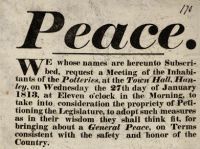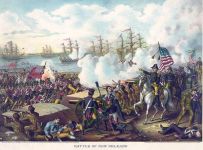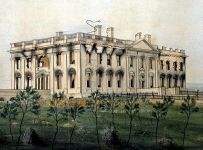War & Peace
 Efforts to end the War of 1812 were initiated almost the moment the conflict began, with diplomatic meetings taking place in London. Although the new British Prime Minister, Lord Liverpool, had withdrawn the orders in council that affected trade, Parliament refused to renounce the policy of impressing American sailors, and war continued. With economic disaster looming, the manufacturing districts, including the Staffordshire Potteries, urged Peace … on Terms consistent with the safety and honour of the Country. In addition to the American skirmishes, the British were also involved in a more prolonged and demanding war with the French. Following their victory over Napoleon in 1814, international maritime trade resumed and Britain no longer needed to reinforce its navy with impressed American seamen.
Efforts to end the War of 1812 were initiated almost the moment the conflict began, with diplomatic meetings taking place in London. Although the new British Prime Minister, Lord Liverpool, had withdrawn the orders in council that affected trade, Parliament refused to renounce the policy of impressing American sailors, and war continued. With economic disaster looming, the manufacturing districts, including the Staffordshire Potteries, urged Peace … on Terms consistent with the safety and honour of the Country. In addition to the American skirmishes, the British were also involved in a more prolonged and demanding war with the French. Following their victory over Napoleon in 1814, international maritime trade resumed and Britain no longer needed to reinforce its navy with impressed American seamen.
 In 181
In 181 4, on August 24, the British sailed up the Potomac River and set fire to Washington where the White House, the Capitol, and many other public buildings were burned. Meanwhile, American forces under the command of Andrew Jackson took the British base at Pensacola, Florida. Then, unaware that Peace had been declared, Jackson marched his forces to Louisiana and routed the British at the battle of New Orleans, in January 1815. Honor had been satisfied and America had asserted her independence from Britain. Peace concluded with The Treaty of Ghent signed December 24, 1814 and ratified in February, 1815.
4, on August 24, the British sailed up the Potomac River and set fire to Washington where the White House, the Capitol, and many other public buildings were burned. Meanwhile, American forces under the command of Andrew Jackson took the British base at Pensacola, Florida. Then, unaware that Peace had been declared, Jackson marched his forces to Louisiana and routed the British at the battle of New Orleans, in January 1815. Honor had been satisfied and America had asserted her independence from Britain. Peace concluded with The Treaty of Ghent signed December 24, 1814 and ratified in February, 1815.
The Staffordshire potters were ready and eager to resume trade immediately, and in the tradition of their earlier commemorative pieces marking the revolutionary war, they created wares that celebrated American victories in War of 1812. These found a ready market as the United States experiences a rising tide of national pride in their first successful defense of democracy.
